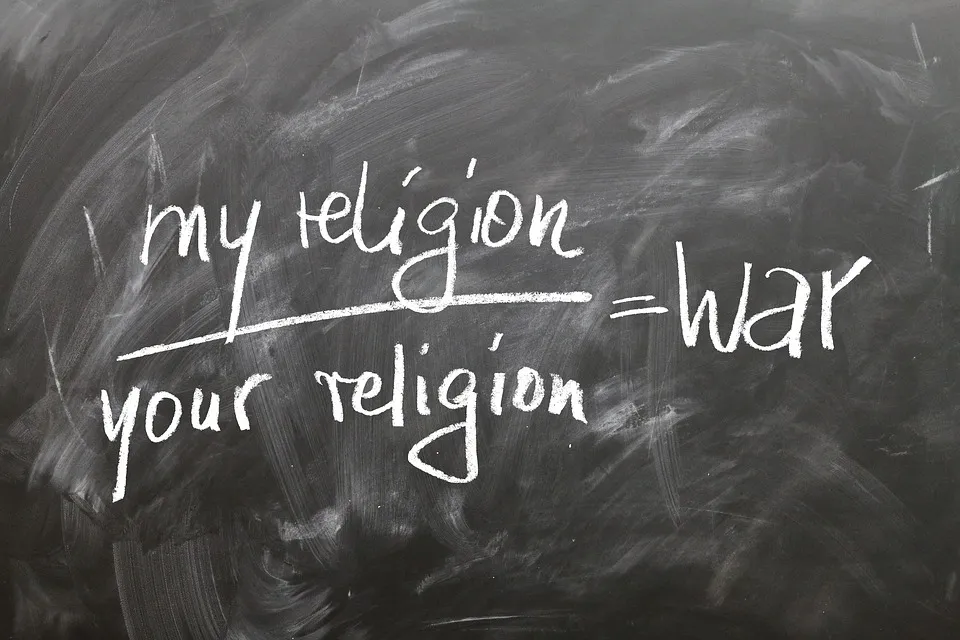A new faith that combines elements of Christianity and Islam has emerged and it’s called Chrislam. Some consider it a symbol of interfaith harmony while others see it as a threat to the two religions. In this article, we explore the origins, practices, and controversies surrounding Chrislam. Read on to discover the intersection between two of the world’s largest religions.
The Definition of Chrislam
You might have come across the term Chrislam before, but what does it actually mean? Simply put, Chrislam is an interfaith movement that seeks to find common ground between Christianity and Islam.

Here’s a breakdown of what Chrislam means:
It aims to promote religious syncretism: Chrislam seeks to blend the beliefs and practices of Christianity and Islam into a hybrid faith. Those who follow Chrislam believe that the two religions are more alike than different and aim to create a spirituality that incorporates both.
It promotes interfaith dialogue: Chrislam also emphasizes building a relationship between Christians and Muslims through interfaith activism and dialogue. This effort to create bridges between the two communities leads to a better understanding of different religious practices and promotes interreligious harmony.
It values religious diversity: Since Chrislam creates a hybrid faith, advocates suggest that it understands and respects religious diversity. It recognizes the important similarities and differences between the Abrahamic religions, namely Christianity and Islam. Chrislam followers believe that religious dialogue and cooperation are essential to create a more peaceful world.
Overall, Chrislam is seen as a modern religion that seeks to promote Islamo-Christian unity through interfaith worship, interfaith ceremony, and is an essential component of the multi-faith movement that advocates for religious tolerance and understanding.

Let’s take a deeper look into Chrislam’s history and how it has become a topic of controversy in recent times.
History of Chrislam
Chrislam, also known as Islomianity, is a relatively new concept that emerged in the 1980s. It originated in Nigeria, where a Muslim cleric, Tela Tella, began preaching about the similarities between Islam and Christianity.
Tella argued that both religions worship the same God and share many common beliefs and values. He encouraged his followers to adopt the best of both religions and to reject the harmful practices and beliefs that do not align with the core teachings of Islam and Christianity.
The idea of Chrislam gained popularity in Nigeria and soon spread to other parts of the world, where it was embraced by interfaith activists and proponents of religious syncretism. In the United States, groups such as the Christian Muslim Alliance have promoted the idea of hybrid religion and interreligious harmony.
Not everyone, however, has embraced Chrislam with open arms. Many traditional Christians and Muslims see it as a threat to their respective faiths and fear that it could lead to the dilution or distortion of their religious traditions. Some have labeled it as a dangerous form of syncretism that blurs the boundaries between the two faiths and creates a confusion about religious identities.
Despite the controversy surrounding Chrislam, its advocates argue that it offers a new way of understanding and practicing religion that is more inclusive, tolerant, and open-minded. They claim that it can help bridge the gaps between the Abrahamic religions and foster a greater sense of unity and cooperation among people of different faiths.
The future of Chrislam remains uncertain, but it is clear that it has already had a significant impact on the religious landscape of the modern world. As the world becomes increasingly diverse and interconnected, hybrid faiths and interfaith partnerships will likely play an increasingly important role in shaping the cultural and spiritual lives of people around the world.
The Controversy Surrounding Chrislam
When it comes to the topic of Chrislam, controversy seems to follow. Some Christian denominations view the blending of Christianity and Islam as an unacceptable practice. They argue that it undermines the fundamental beliefs of both faiths and dilutes the significance of each one. On the other side of the aisle, proponents of Chrislam argue that it is a positive notion, promoting peace, love, and unity between the two prominent Abrahamic religions.
Let’s take a closer look at some of the main arguments surrounding the practice of Chrislam:
Compatibility: Critics assert that Christianity and Islam have fundamentally different beliefs that cannot be reconciled. They argue that trying to combine the two creates a hybrid religion that is neither Christian nor Muslim but rather a new, man-made faith.
Theological Conflicts: Some Christian denominations view Chrislam as theologically incompatible with traditional Christianity. For example, they believe that the denial of the divinity of Jesus Christ (a central tenet of Islam) directly contradicts the core Christian belief in Jesus as the Son of God.
Religious Syncretism: Other opponents of Chrislam view this movement as an example of religious syncretism, which they believe is a violation of both faiths. They argue that Chrislam attempts to merge two religions that cannot be blended together without compromising their fundamental beliefs.
Cultural Integration: Many Christians see Chrislam as a gateway to cultural integration, where Islamist beliefs common to one culture are blended with Christian beliefs specific to another culture. For some, this is seen as a thinly veiled attempt at cultural assimilation.

Undeniably, Chrislam is a controversial topic. Nevertheless, proponents of Chrislam believe that interfaith dialogue is essential to promoting peace, love, and understanding between different faiths. They view this practice as an opportunity to learn from one another and discover what each religion has to offer.
Despite the controversy, many communities have begun to adopt Chrislam as part of their worship practices. This hybrid faith may not be accepted by everyone but is, nonetheless, an interesting approach to interfaith theology that deserves exploration.
Distinguishing Chrislam from Traditional Christianity and Islam
As previously discussed, Chrislam is a hybrid religion that aims to bridge the gap between Christianity and Islam. It is important to distinguish Chrislam from traditional Christianity and Islam to avoid confusion and misrepresentation.
Firstly, it is essential to recognize that Chrislam is not an organized religion in the same way that Christianity and Islam are. While many Christian denominations and Islamic sects have established structures and hierarchies, Chrislam does not have a central governing body. It is a grassroots movement that has grown out of interfaith dialogues and relationships.
Secondly, Chrislam is not a replacement or alternative to Christianity or Islam. Those who practice Chrislam do not denounce their original faith but rather seek to integrate both religions’ teachings and practices into their spiritual lives. Chrislam does not reject the core beliefs of either Christianity or Islam but rather seeks common ground in certain areas.
Thirdly, Chrislam does not promote syncretism, the practice of blending different religions into a new form of worship. Syncretism implies that one religion is superior to the other, and elements from the other faith are adopted to supplement the primary religion. This is not the aim of Chrislam, which champions the individual’s right to worship in their way while also promoting mutual understanding and respect between different faiths.
Lastly, Chrislam is not a new religion but rather a modern incarnation of interfaith dialogue and religious diversity. Interfaith discussions and efforts to understand other faiths have been happening throughout history, but Chrislam represents a contemporary approach that acknowledges the reality of religious diversity in modern society.
In conclusion, understanding the differences between Chrislam and traditional Christianity and Islam is crucial to avoid misrepresentation and confusion. Chrislam does not seek to replace or denounce any religion but rather integrate and reconcile them in a way that promotes unity and mutual respect.
Examples of Chrislam Practices
If you’re wondering what Chrislam looks like in practice, you’ll be surprised to learn that it can take many forms. Below are some examples of Chrislam practices:
Joint worship services: One of the most common practices of Chrislam is joint worship between Christians and Muslims. In some cases, this means that a Muslim imam and a Christian pastor will co-lead a service, blending elements of both religions in the prayers, music, and readings. In other cases, Christians and Muslims will alternate hosting services at each other’s places of worship.
Interfaith dialogue: Chrislam is often about building relationships between Christians and Muslims through dialogue. Interfaith dialogue can take place in many settings, including conferences, meetings, and even in family homes. These conversations can help participants gain a deeper understanding of each other’s beliefs and cultures.
Sharing religious texts: In interfaith settings, Christians and Muslims may share their holy texts with each other as a way of building bridges. Muslims may share parts of the Quran with Christians, while Christians may share parts of the Bible with Muslims. This can result in new interpretations of familiar texts and a deeper understanding of each other’s beliefs.
Social justice activism: Many Chrislam organizations focus on social justice issues, such as poverty, hunger, and homelessness. Christians and Muslims may work together to address these issues, drawing on the teachings of both religions to inspire their actions.
Building interfaith communities: Some Chrislam communities focus on creating shared spaces and events for Christians and Muslims to come together. For example, a community garden might be started and tended by both Christians and Muslims, or a interfaith music festival might be organized.
While these practices are not exclusive to Chrislam, they are all examples of how Christians and Muslims can come together to build understanding and respect for each other’s faiths.
The Future of Chrislam

As the world becomes more interconnected, the need for interfaith harmony and cooperation increases. Chrislam, as a hybrid religion born from the intersection of Christianity and Islam, provides a unique opportunity for individuals to come together in a spirit of mutual understanding and respect.
Although Chrislam has faced controversy and criticism from both Christian and Muslim communities, it has also gained traction among interfaith activists and those seeking to bridge the gap between the two faiths. As such, the future of Chrislam remains uncertain but promising.
Advocates of Chrislam believe that it has the potential to inspire a wider interfaith movement that promotes respect and appreciation for the diversity of spiritual beliefs. The emphasis on shared values such as love, peace, and compassion can unite individuals from different cultural backgrounds and faith traditions.
Furthermore, Chrislam can serve as a model for how to navigate the complex dynamics of interfaith marriages and families. With religious diversity on the rise in many parts of the world, Chrislam could offer a path for couples that seek harmony and understanding in their relationship.
In some Christian and Muslim communities, Chrislam has already gained a foothold with hybrid worship and prayer services. As this trend continues, we may see more interfaith ceremonies and rituals that blend elements of Christian and Muslim traditions.

However, the future of Chrislam is not without its challenges. The criticism from more conservative members of both Islam and Christianity could lead to opposition and possible conflict. The theological nuances of Chrislam and its compatibility with the foundational beliefs of Christianity and Islam are also an ongoing debate.
Regardless of its future, Chrislam serves as a testament to the power of interfaith dialogue and cooperation. It offers a unique perspective on the compatibility of two faith traditions that are often seen as mutually exclusive. As our world becomes increasingly diverse and interconnected, it is important to continue exploring new ways to foster intercultural and interfaith understanding.













